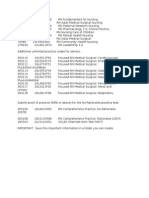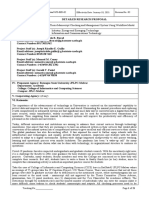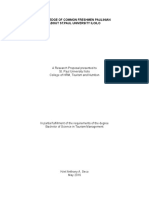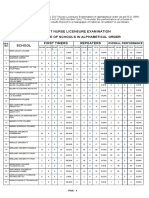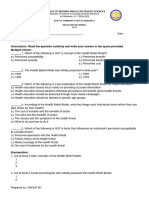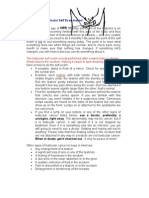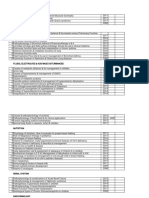0 ratings0% found this document useful (0 votes)
56 viewsHMIS M&E-Transcript
HMIS M&E-Transcript
Uploaded by
Charmaine Krystel RamosThe document discusses monitoring and evaluation (M&E) of health management information systems (HMIS). It provides information on M&E frameworks for various health programs in countries. Key points include:
1) Monitoring involves collecting, analyzing, and using data to assess progress, account for resources, and make decisions. Evaluation assesses completed or ongoing programs objectively.
2) HMIS indicators are selected to monitor performance of health programs and services. These provide data on resources, maternal and child health interventions, and programs like STOP TB.
3) Frameworks establish common M&E platforms and alignment between country and global systems to strengthen health services. Data is used for decision-making.
Copyright:
© All Rights Reserved
Available Formats
Download as PDF, TXT or read online from Scribd
HMIS M&E-Transcript
HMIS M&E-Transcript
Uploaded by
Charmaine Krystel Ramos0 ratings0% found this document useful (0 votes)
56 views6 pagesThe document discusses monitoring and evaluation (M&E) of health management information systems (HMIS). It provides information on M&E frameworks for various health programs in countries. Key points include:
1) Monitoring involves collecting, analyzing, and using data to assess progress, account for resources, and make decisions. Evaluation assesses completed or ongoing programs objectively.
2) HMIS indicators are selected to monitor performance of health programs and services. These provide data on resources, maternal and child health interventions, and programs like STOP TB.
3) Frameworks establish common M&E platforms and alignment between country and global systems to strengthen health services. Data is used for decision-making.
Original Description:
cdaffffffffffffffffffffffffffffffffffffffffffffffffffffffffff
Original Title
HMIS M&E-Transcript.docx
Copyright
© © All Rights Reserved
Available Formats
PDF, TXT or read online from Scribd
Share this document
Did you find this document useful?
Is this content inappropriate?
The document discusses monitoring and evaluation (M&E) of health management information systems (HMIS). It provides information on M&E frameworks for various health programs in countries. Key points include:
1) Monitoring involves collecting, analyzing, and using data to assess progress, account for resources, and make decisions. Evaluation assesses completed or ongoing programs objectively.
2) HMIS indicators are selected to monitor performance of health programs and services. These provide data on resources, maternal and child health interventions, and programs like STOP TB.
3) Frameworks establish common M&E platforms and alignment between country and global systems to strengthen health services. Data is used for decision-making.
Copyright:
© All Rights Reserved
Available Formats
Download as PDF, TXT or read online from Scribd
Download as pdf or txt
0 ratings0% found this document useful (0 votes)
56 views6 pagesHMIS M&E-Transcript
HMIS M&E-Transcript
Uploaded by
Charmaine Krystel RamosThe document discusses monitoring and evaluation (M&E) of health management information systems (HMIS). It provides information on M&E frameworks for various health programs in countries. Key points include:
1) Monitoring involves collecting, analyzing, and using data to assess progress, account for resources, and make decisions. Evaluation assesses completed or ongoing programs objectively.
2) HMIS indicators are selected to monitor performance of health programs and services. These provide data on resources, maternal and child health interventions, and programs like STOP TB.
3) Frameworks establish common M&E platforms and alignment between country and global systems to strengthen health services. Data is used for decision-making.
Copyright:
© All Rights Reserved
Available Formats
Download as PDF, TXT or read online from Scribd
Download as pdf or txt
You are on page 1of 6
HMIS Monitoring and Evaluation
MONITORING- are the systematic collection,
❖ Progress of any medical institution are
analysis, and use of information for three basic
purposes: monitored and evaluated through
various activities such as monitoring
1. Learning from experience reports, HMIS, surveys and evaluation
studies.
2. Accounting internally and externally for
resources used ❖ Be primarily country-focused but also
offer the basis for global monitoring;
3. The results obtained and taking decisions
❖ Address M&E needs for multiple users
EVALUATION- assessing an on-going or
and purposes, including monitoring
completed program or policy as systematically
program inputs, processes and results,
and as objectively as possible.
tracking health systems performance
The object is to be able to: and evaluation;
❖ Facilitate the identification of
❖ Make statements about their relevance,
indicators and data sources, provide
effectiveness, efficiency, impact and tools and guidance for data analysis,
and show how the data can be
communicated and used for
decision-making
❖ Bring together the monitoring and
evaluation work in disease-specific
programs with cross-cutting efforts
sustainability.
such as tracking human resources,
logistics and procurement, and health
service delivery.
The primary aim is to have a strong M&E
and review system in place for the national
health strategic plan that comprises all major
disease programs and health systems.
❖ The framework builds upon principles
derived from the Paris declaration on
aid harmonization and effectiveness
and the IHP+, putting country health
The national M&E plan and system should strategies, and the related M&E
address all components of the framework and processes such as annual health sector
lay the foundation for regular reviews during reviews, at the center.
the implementation of the national plan. ❖ The core is the strengthening of a
common country platform for M&E of
HMIS Monitoring and Evaluation
HSS, which should result in better
alignment of country and global M&E
systems An indicator can be defined as a
variable whose value changes. It is a
measurement that measures the value of
the change in meaningful units that can be
compared to past and future units
The World Health Organization Monitoring
and Evaluation Health System Strengthening
Framework
HMIS Monitoring and Evaluation
Common Framework for Monitoring
Performance & Evaluating Progress in The
Scale For Better Health
❖ HMIS is a source of routine data snapshot of the available health
that is necessary for monitoring resources.
different aspects of various health
programs implemented in the Example:
country.
❖ The HMIS indicators have been ❖ Maternal Survival Intervention Child
carefully selected to meet the key ❖ Mortality and Child Survival
information needs of monitoring the Intervention
performance of various health ❖ STOP TB Program
programs and services and provide a
HMIS Monitoring and Evaluation
The Maternal Survival Strategy and
HMIS indicators
❖ The Maternal Survival Strategies
lays down a framework for achieving
the fifth Millennium Development
Goal of reducing maternal mortality.
❖ Given the complexity of the country
contexts and the determinants of
maternal health, none of the maternal
survival intervention alone can
reduce the maternal mortality rate.
❖ Rather, evidences support packaging
of health facility oriented
interventions is highly effective and
has high coverage of the intended
target group.
HMIS INDICATORS RELATED TO
INTRAPARTUM CARE:
❖ Deliveries by skilled attendance (at
health facilities)
❖ Deliveries by Health Extension
Workers (HEW) (at home of Health
Posts)
❖ Institutional cases of maternal
morbidity and mortality due to
Obstructed labor
❖ 1st postnatal care attendance
❖ Institutional cases of maternal
morbidity and mortality due to
postpartum hemorrhage (PPH)
and Puerperal sepsis
HMIS Monitoring and Evaluation
❖ Family planning method acceptors
(New and Repeat)
❖ Family planning methods issued by
type of method
❖ Ethiopia is one of those countries
who have made great strides
towards reducing the under-5
mortalities based on Ethiopia
Maternal and Child Health Data
(2012).
❖ However, under-5 mortalities still
remain high at 106 per 1000 live
births (LB) in 2010 and the country
Ethiopia is implementing interventions
faces the challenge of reducing it to
targeting under 5-year-old children
61/1000 LB by 2015.
through:
❖ The EDHS 2011 estimated under-5
mortalities to be 88 per 1000 LB that ❖ Universal Immunization Coverage,
is a 47% decline from 166/1000 LB ❖ Nutrition program,
in 2000. Diarrhea, pneumonia, ❖ Integrated Management of
measles, malaria, HIV/AIDS, birth Childhood Illnesses and the
asphyxia, preterm delivery, neonatal Community Case Management of
tetanus and neonatal sepsis are the Childhood Illnesses
major causes of under-5 deaths in ❖ Through Health Development Army
Ethiopia, with under-nutrition to –improve water, sanitation and
attributing to over one third of these hygiene–Malaria prevention through
deaths. Integrated Household Spraying and
distribution of Insecticide Treated
Nets (ITN) (USAID, 2013).
In the context of the above these child
survival interventions, the related HMIS
indicators are:
HMIS Monitoring and Evaluation
❖ Number of treatments for children ❖ The following flowchart puts the
under five provided by health facility HMIS indicators (in green shaded
by disease: Diarrhea, dysentery, boxes) in the context of the STOP
pneumonia, measles, malaria, TB Program.
neonatal tetanus
❖ Number of infants immunized for
measles
❖ Latrine coverage
❖ Safe water coverage
❖ Household with ITN
❖ With the vision to have a TB free
world, the goal of the STOP TB
Program (STP) is to dramatically
reduce the global burden of TB by
2015, in line with the Millennium
Development Goals and the Stop
TB Partnership targets of the HMIS Indicators to Monitor STOP TB
World Health Organization (2006). Program
❖ One of the main objectives of the
❖ TB patients on DOTS
program is to achieve universal
❖ Number of new smear pulmonary TB
access to high-quality care (i.e.
cases enrolled in the cohort
universal access to high quality ❖ TB Case Detection
diagnosis and patient centered ❖ Number of New smear positive
treatment) for all people with TB pulmonary TB cases detected
(including those co-infected with ❖ Number of new smear negative
HIV and those with drug-resistant pulmonary TB cases detected
TB). ❖ Number of new extra pulmonary TB
❖ TB case detection and successful cases detected
completion of the treatment/cure of ❖ HIV –TB –Co-infection
the TB remains at the core of the ❖ Proportion of newly diagnosed TB cases
tested to HIV
Stop TB Strategy. Hence one of the
❖ HIV+ new TB patients enrolled in
targets linked to the MDGs and
DOTS
endorsed by the Stop TB Partnership ❖ TB Treatment outcome •Treatment
is by 2050 to reduce prevalence and completed PTB+
deaths due to TB by 50% compared ❖ Cured PTB+, Defaulted PTB+, Deaths
with a baseline of 1990. PTB+
You might also like
- Medical Billing Training ManualDocument51 pagesMedical Billing Training ManualRadha Raman Sharma100% (7)
- Chemistry Is Project Class 12Document14 pagesChemistry Is Project Class 12Deepak Purbia100% (1)
- Laboratory Activity - HIS Lab - IDTOMISDocument2 pagesLaboratory Activity - HIS Lab - IDTOMISFrance Cedrick RamosNo ratings yet
- Organizational Chart CritiqueDocument7 pagesOrganizational Chart Critiqueapi-666242639100% (1)
- Narrative Report GuidelinesDocument3 pagesNarrative Report GuidelinesMichael KitNo ratings yet
- Module 2 The FamilyDocument26 pagesModule 2 The FamilyFrancine De Los Reyes100% (1)
- Ati Codes Cont'Document1 pageAti Codes Cont'm1k0eNo ratings yet
- dm2024-0333-2 Clarification On Reporting of Notiafiable DiseasesDocument19 pagesdm2024-0333-2 Clarification On Reporting of Notiafiable DiseasesHRH SAN GABRIELNo ratings yet
- Health As Human RightDocument2 pagesHealth As Human RightGina CruzNo ratings yet
- Student Satisfaction Survey On Student Affairs and Services (Sas) Programs of Western Philippines UniversityDocument11 pagesStudent Satisfaction Survey On Student Affairs and Services (Sas) Programs of Western Philippines Universityjonathan lindaoNo ratings yet
- Health Informatics in The PhilippinesDocument2 pagesHealth Informatics in The Philippineswheathering withyouNo ratings yet
- ICT Application To Technical Report Writing, RecordDocument14 pagesICT Application To Technical Report Writing, Recordanon_230653802100% (1)
- BatStateU FO RES 02 - Detailed Research Proposal Rev. 02 - ThesisCheckingDocument21 pagesBatStateU FO RES 02 - Detailed Research Proposal Rev. 02 - ThesisCheckingLesterSanchezCuevaNo ratings yet
- HIS-district LaboratoryDocument6 pagesHIS-district LaboratoryEricka Genove100% (1)
- LESSON 8 - HMIS Data QualityDocument4 pagesLESSON 8 - HMIS Data QualityKlint LeyesaNo ratings yet
- First Semester A.Y. 2021 - 2022: Overview of Health Informatics Learning ObjectivesDocument4 pagesFirst Semester A.Y. 2021 - 2022: Overview of Health Informatics Learning ObjectivesFea Kristine PacquiaoNo ratings yet
- 10 Golden Rules in MedicationDocument2 pages10 Golden Rules in MedicationYha Nha Rhu100% (1)
- Exercise 3Document11 pagesExercise 3Richard Aba100% (2)
- Health Information System Lesson 1Document7 pagesHealth Information System Lesson 1rodNo ratings yet
- Lesson 12: Materials Management SystemDocument9 pagesLesson 12: Materials Management SystemClarisse De GuzmanNo ratings yet
- Health Informatics in The PhilippinesDocument4 pagesHealth Informatics in The PhilippinesBillyPedronNo ratings yet
- NRes1 Course Unit 1Document6 pagesNRes1 Course Unit 1Jamie NarcisoNo ratings yet
- NCM 112 - Rubric For Case Presentation Part 1 - 2021 - Laf 1Document3 pagesNCM 112 - Rubric For Case Presentation Part 1 - 2021 - Laf 1Leslie CruzNo ratings yet
- NCM 110 1-A LectureDocument22 pagesNCM 110 1-A Lecture1G - Kyle Kenjie DahiliNo ratings yet
- Cardiology Information System: Lesson 11: Other Hospital Information SystemsDocument3 pagesCardiology Information System: Lesson 11: Other Hospital Information SystemsClarisse De Guzman100% (1)
- Course Syllabus For Biostatistics For Applied Health Research STAT 301Document4 pagesCourse Syllabus For Biostatistics For Applied Health Research STAT 301bea100% (1)
- 2023 OBE Syllabus - Medical Office ProceduresDocument26 pages2023 OBE Syllabus - Medical Office ProceduresJeffreyReyesNo ratings yet
- Thematic AnalysisDocument13 pagesThematic AnalysiseinsteinNo ratings yet
- Healing The Divide: Navigating Healthcare Inequities in The PhilippinesDocument7 pagesHealing The Divide: Navigating Healthcare Inequities in The PhilippinesClarence guirit100% (1)
- Ver1.admission Policies of Cagayan State UniversityDocument20 pagesVer1.admission Policies of Cagayan State UniversityAshley DayagNo ratings yet
- Hmis Monitoring and Evaluation: Lesson 7Document10 pagesHmis Monitoring and Evaluation: Lesson 7Jennifer Ledesma-PidoNo ratings yet
- Health Assessment Lecture ReviewerDocument18 pagesHealth Assessment Lecture ReviewerMinminkajaNo ratings yet
- Nursing Informatics Module 3 5Document13 pagesNursing Informatics Module 3 5Al TheóNo ratings yet
- NCM110 Nursing Informatics FinalsDocument7 pagesNCM110 Nursing Informatics FinalsSteph CaronanNo ratings yet
- Lesson 6 - Health Management Information SystemsDocument20 pagesLesson 6 - Health Management Information SystemsManlapaz Marc AndreiNo ratings yet
- Second Sem Module in MILDocument48 pagesSecond Sem Module in MILallysa canaleNo ratings yet
- OBE FormatDocument1 pageOBE FormatMaria Caridad L. MutiaNo ratings yet
- Bsit 3-1 Reviewer - Insy 55Document7 pagesBsit 3-1 Reviewer - Insy 55Mark Nathan BatulaNo ratings yet
- Knowledge of Common Freshmen Paulinians About St. Paul University IloiloDocument45 pagesKnowledge of Common Freshmen Paulinians About St. Paul University IloiloKendrickAlbasonCallao50% (2)
- Health Education Teaching Methods QuizDocument2 pagesHealth Education Teaching Methods QuizJennifer Davis CondimanNo ratings yet
- Perception of Coc Pup Students For Twitter As A Source of InformationDocument29 pagesPerception of Coc Pup Students For Twitter As A Source of Informationmark aljon fajardoNo ratings yet
- His Lesson 6Document1 pageHis Lesson 6Jaycarlo SaltivanNo ratings yet
- Community Health Care Management Syllabus: InstructorDocument6 pagesCommunity Health Care Management Syllabus: InstructorkrissyNo ratings yet
- The Significance of Immunization in The Prevention of Childhood Killer DiseasesDocument69 pagesThe Significance of Immunization in The Prevention of Childhood Killer DiseasesUsman Ahmad Tijjani100% (1)
- Ca1 Pen SyllabusDocument6 pagesCa1 Pen SyllabusJoseph Bahian-AbangNo ratings yet
- NSTP Guidelines Policies FinalDocument1 pageNSTP Guidelines Policies FinaljuennaguecoNo ratings yet
- BS in Radiologic Technology in The PhilippinesDocument5 pagesBS in Radiologic Technology in The PhilippinesRegalado Aguhayon100% (1)
- Performance of Schools June 2017 NLEDocument17 pagesPerformance of Schools June 2017 NLETheSummitExpress75% (4)
- Certification RLE DUTYDocument4 pagesCertification RLE DUTYronronNo ratings yet
- Nursing InformaticsDocument18 pagesNursing Informaticscheskalyka.asiloNo ratings yet
- Sexual and Reproductive Health Rights FOWODEDocument39 pagesSexual and Reproductive Health Rights FOWODEMayom MabuongNo ratings yet
- HBM Quiz and Ans KeyDocument3 pagesHBM Quiz and Ans Keycarlluiscupido09No ratings yet
- Competency AssessmentDocument12 pagesCompetency Assessmentapi-562799189100% (1)
- Questionnaire On TelemedicineDocument4 pagesQuestionnaire On TelemedicineNutan Panda50% (2)
- 01 FHSIS Clarificatory F1 Plus PresentationDocument59 pages01 FHSIS Clarificatory F1 Plus PresentationMARJORIE PALMITOSNo ratings yet
- Philippine Integrated Disease Surveillance and Response (Pidsr) "PIDSR A Bedrock of Effective Disease Surveillance" - Secretary DuqueDocument4 pagesPhilippine Integrated Disease Surveillance and Response (Pidsr) "PIDSR A Bedrock of Effective Disease Surveillance" - Secretary DuqueRoel AbricaNo ratings yet
- Health Management Information System: Three Main ComponentsDocument6 pagesHealth Management Information System: Three Main Componentssam peligroNo ratings yet
- His Lab OnlyDocument21 pagesHis Lab OnlyCookie Monster100% (1)
- Mty1106 Lec7Document5 pagesMty1106 Lec7IJustWannaSleepNo ratings yet
- Community Health NursingDocument17 pagesCommunity Health NursingdianaeleriaNo ratings yet
- Lesson 7 Hmis Monitoring and Evaluation: Buenafe, DrexlerDocument12 pagesLesson 7 Hmis Monitoring and Evaluation: Buenafe, DrexlerFaye Dianne Damian-BuenafeNo ratings yet
- BMJ k2785 FullDocument5 pagesBMJ k2785 FullTamiru BogaleNo ratings yet
- Disease Surveillance - Concepts PDF 17062022Document38 pagesDisease Surveillance - Concepts PDF 17062022ayomideolaniran14No ratings yet
- His Reporting FinaleDocument16 pagesHis Reporting FinaleThyroneNo ratings yet
- Alkyl Halide TranscriptDocument1 pageAlkyl Halide TranscriptCharmaine Krystel RamosNo ratings yet
- CASUTT TranscriptDocument3 pagesCASUTT TranscriptCharmaine Krystel RamosNo ratings yet
- Clinical Data Repositories PDFDocument3 pagesClinical Data Repositories PDFCharmaine Krystel RamosNo ratings yet
- Microscopy TransDocument11 pagesMicroscopy TransCharmaine Krystel RamosNo ratings yet
- Assignment in Physics 2Document8 pagesAssignment in Physics 2Charmaine Krystel RamosNo ratings yet
- Assignment in EmtechDocument2 pagesAssignment in EmtechCharmaine Krystel RamosNo ratings yet
- Assignment in Filipino PanimulaDocument2 pagesAssignment in Filipino PanimulaCharmaine Krystel RamosNo ratings yet
- Assignment in EmtechDocument2 pagesAssignment in EmtechCharmaine Krystel RamosNo ratings yet
- What MS Word Feature You Like The Most? What It Looks Like?Document1 pageWhat MS Word Feature You Like The Most? What It Looks Like?Charmaine Krystel RamosNo ratings yet
- November 2022 State RegisterDocument3,453 pagesNovember 2022 State RegisterpawanNo ratings yet
- Acido Jasmónico-Hoja de SeguridadDocument10 pagesAcido Jasmónico-Hoja de SeguridadJack BravoNo ratings yet
- Effectiveness of Structured Teaching Programme On The Level of Knowledge Regarding Upper Respiratory Tract Infection Among Mothers of Under Five ChildrenDocument4 pagesEffectiveness of Structured Teaching Programme On The Level of Knowledge Regarding Upper Respiratory Tract Infection Among Mothers of Under Five ChildrenEditor IJTSRD100% (1)
- Kindergarten Thesis TopicsDocument8 pagesKindergarten Thesis Topicsbkxgnsw4100% (1)
- CT Information For Contract PreparationDocument7 pagesCT Information For Contract PreparationAnime loverNo ratings yet
- CauterizationDocument34 pagesCauterizationBABANG GAGAHNo ratings yet
- Foo Fio NaDocument13 pagesFoo Fio NaadidayaNo ratings yet
- Why Growth Is Not Enough Household Poverty Dynamics in Northeast Gujarat IndiaDocument31 pagesWhy Growth Is Not Enough Household Poverty Dynamics in Northeast Gujarat IndiaPallabi GuhaNo ratings yet
- Vocal Health, Voice Self - Concept and Quality of Lifw in German School Teachers.j.jvoice.2018.11.008Document11 pagesVocal Health, Voice Self - Concept and Quality of Lifw in German School Teachers.j.jvoice.2018.11.008Anamaria FilipasNo ratings yet
- Federal Policy PlatformDocument9 pagesFederal Policy PlatformHeidi SimonNo ratings yet
- LP Writing TechniquesDocument11 pagesLP Writing TechniquesLykaNo ratings yet
- Soap NotesDocument6 pagesSoap NotesJust HelpingNo ratings yet
- Student Technolgy Task Cards Nutrition LessonDocument5 pagesStudent Technolgy Task Cards Nutrition Lessonapi-394238782No ratings yet
- DAFTAR PUSTAKA Proposal FixDocument8 pagesDAFTAR PUSTAKA Proposal FixrahmaNo ratings yet
- The Impact of Social Media On Society - Navigating The Digital LandscapeDocument2 pagesThe Impact of Social Media On Society - Navigating The Digital LandscapeRicardo Gulapa100% (1)
- Indoor Air Quality (Slide Presentation)Document10 pagesIndoor Air Quality (Slide Presentation)Nama Saya SyedNo ratings yet
- Additional Doc PaclibarDocument6 pagesAdditional Doc PaclibarJoherNo ratings yet
- 1-S2.0-S2210670723003372-Main 2Document22 pages1-S2.0-S2210670723003372-Main 2badamchipNo ratings yet
- Preparations of Parents For The New Normal Classes: A Cross-Case AnalysisDocument33 pagesPreparations of Parents For The New Normal Classes: A Cross-Case AnalysisPsychology and Education: A Multidisciplinary JournalNo ratings yet
- Review of Related LiteratureDocument11 pagesReview of Related LiteratureJenniferAnneAlegre100% (1)
- Compare & Contrast Graphic Organizer Comparation of Covid - 19 Vaccines (Sinovac and Astrazeneca Vaccines)Document4 pagesCompare & Contrast Graphic Organizer Comparation of Covid - 19 Vaccines (Sinovac and Astrazeneca Vaccines)Mochi-chanNo ratings yet
- Medical Surgical Nursing Review SeriesDocument23 pagesMedical Surgical Nursing Review SeriesseigelysticNo ratings yet
- Dynamic Physical Education For Secondary School Students Seventh Edition 1292020520 9781292020525 9781292033815 1292033819 - CompressDocument493 pagesDynamic Physical Education For Secondary School Students Seventh Edition 1292020520 9781292020525 9781292033815 1292033819 - CompressMarcos VandersonNo ratings yet
- How To Do A Testicular Self ExaminationDocument4 pagesHow To Do A Testicular Self Examinationphoenix_neil12No ratings yet
- Anestesia Locoregional y AnticoagulantesDocument6 pagesAnestesia Locoregional y Anticoagulantesluis castro martinezNo ratings yet
- Me Pediatrics Ntruhs Previous Question Papers Chapter WiseDocument9 pagesMe Pediatrics Ntruhs Previous Question Papers Chapter WiseNarendra AnnaladasuNo ratings yet






